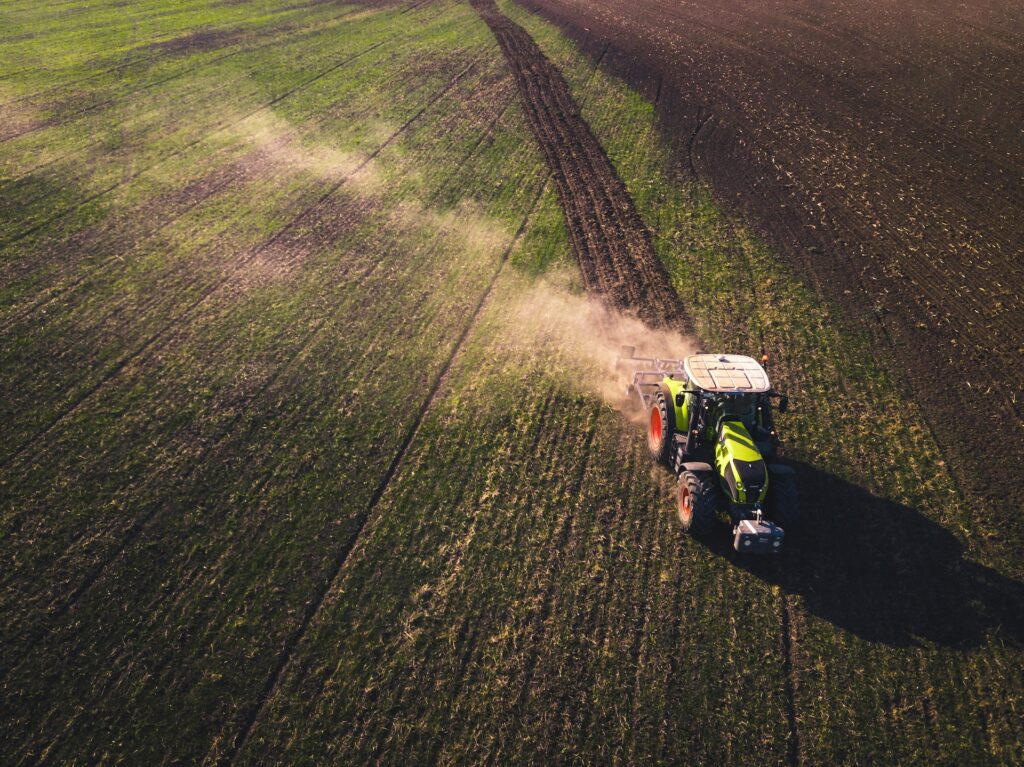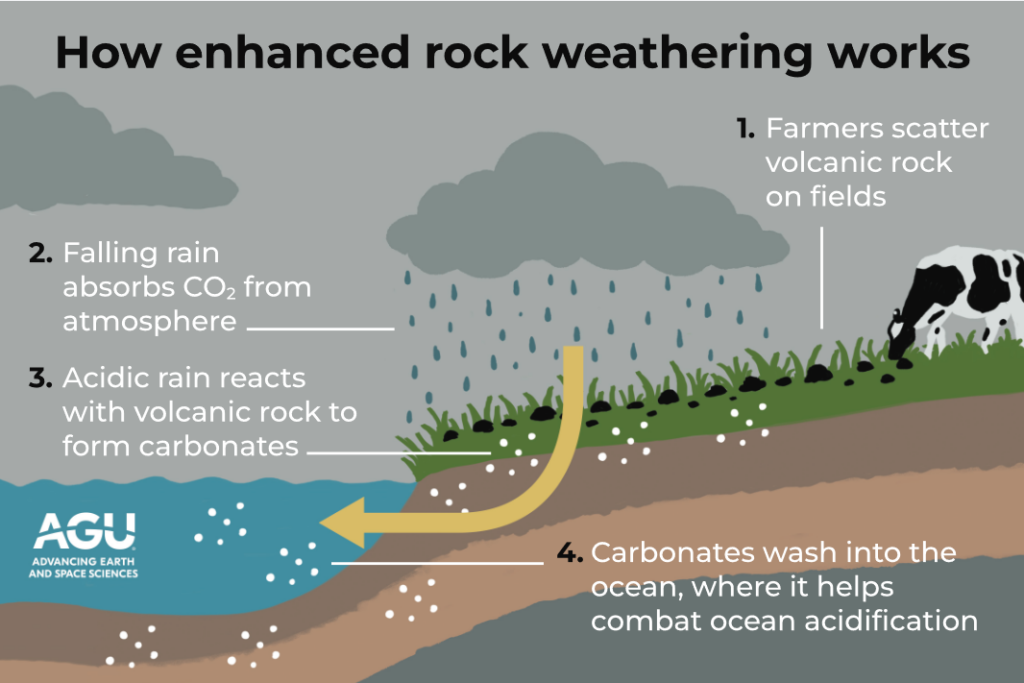Adding crushed volcanic rocks to agricultural fields can both improve the soil and suck down carbon dioxide. Doing so in the hot, humid tropics would be most efficient, a new study finds
14 August 2023

A climate intervention strategy called enhanced rock weathering, if applied globally, could help meet a key IPCC goal for slowing climate change, according to new research published in the AGU journal Earth’s Future. Credit: Chris Ensminger/Unsplash
AGU press contact:
Rebecca Dzombak, [email protected] (UTC-4 hours)
Contact information for the researchers:
S. Hun Baek, Yale University, [email protected] (UTC-4 hours)
Noah Planavsky, Yale University, [email protected] (UTC-4 hours)
Key points:
- Enhanced rock weathering makes use of a natural geologic process to store carbon long term
- Applying 10 tons of basalt dust per hectare of crop land globally could sequester up to 217 gigatons of carbon dioxide in 75 years, above the IPCC’s lower threshold of carbon dioxide removal needed to reach climate goals, along with emissions reductions
- Farms in the tropics have the biggest and fastest return on investment
WASHINGTON — Farmers around the world could help the planet reach a key carbon removal goal set by the Intergovernmental Panel on Climate Change (IPCC) by mixing crushed volcanic rocks into their fields, a new study reports. The study also highlights wet, warm tropics as the most promising locations for this climate intervention strategy.
The study provides one of the first global estimates of the potential carbon dioxide drawdown from basalt application on agricultural fields worldwide. It was published in Earth’s Future, AGU’s journal for interdisciplinary research on the past, present and future of our planet and its inhabitants.
This type of climate intervention is called enhanced rock weathering. It takes advantage of the weathering process, which naturally sequesters carbon dioxide in carbonate minerals. The idea is simple: speed up weathering in a way that also benefits people. When used in parallel with emissions reductions, it can help slow the pace of climate change.
And it may be a safer bet than other carbon drawdown approaches, according to the study authors.
“Enhanced rock weathering poses fewer risks compared to other climate interventions,” said S. Hun Baek, a climate scientist at Yale University who led the study. “It also provides some key benefits, like rejuvenating depleted soils and countering ocean acidification, that may make it more socially desirable.”
The new study explores the potential of applying crushed basalt, a fast-weathering rock that forms as lava cools, to agricultural fields around the world and highlights which regions can most efficiently break down the rocks.

Enhanced rock weathering improves soil health, sequesters carbon, and combats ocean acidification. (Carbonates can also come from non-enhanced soil.) Credit: AGU
“There’s tremendous potential here,” said Noah Planavsky, a geochemist at Yale University who co-authored the study. “Although we still have things to learn from a basic science perspective, there is promise, and we need to focus on what we can do from market and finance perspectives.”
A previous study used a separate method of calculating carbon dioxide removal to estimate carbon drawdown by the year 2050, but the researchers wanted to look beyond country borders and further into the future.
The researchers used a new biogeochemical model to simulate how applying crushed basalt to global croplands would draw down carbon dioxide, to test the sensitivity of enhanced rock weathering to climate and to pinpoint the areas where the method could be most effective.
The new model simulated enhanced rock weathering on 1,000 agricultural sites around the world under two emissions scenarios from 2006 to 2080. They found that in the 75-year study period, those agricultural sites would draw down 64 gigatons of carbon dioxide. Extrapolating that to all agricultural fields, representing the world’s total potential application of this strategy, up to 217 gigatons of carbon could be sequestered in that time period.
“The latest IPCC report said we need to remove 100 to 1,000 gigatons of carbon by 2100 in addition to steeply reducing emissions to keep global temperature from rising more than one and a half degrees Celsius,” said Baek. “Scaling up to global croplands, the estimates of carbon removal we found are roughly comparable to the lower end of that range needed to have a fighting chance of meeting those climate goals.”
Because weathering progresses more quickly in hot and wet environments, enhanced rock weathering would work more quickly in tropical regions than higher latitudes, the study highlights. Farmers and companies looking to invest in carbon drawdown solutions make cost- and carbon-efficient choices by targeting basalt application in tropical fields.
The model revealed another promising result: Enhanced rock weathering works just as well, if not a little better, in warmer temperatures. Some other carbon drawdown approaches, such as those that rely on soil organic carbon storage, become less effective with continual warming.
“Enhanced rock weathering is surprisingly resilient to climate change,” Baek said. “Our results show that it’s relatively insensitive to climate change and works about the same under moderate and severe global warming scenarios. This gives us confidence in its potential as a long-term strategy.”
Farmers already apply millions of tons of limestone (a calcium carbonate rock that can either be a carbon source or sink) to their fields to deliver nutrients and control soil acidity, so gradually changing the rock type could mean a smooth transition to implementing enhanced rock weathering at scale, Planavsky said.
Enhanced rock weathering has been applied on small scales on farms around the world. The next step is working toward “realistic implementation,” Planavsky said.
#
AGU (www.agu.org) is a global community supporting more than half a million advocates and professionals in Earth and space sciences. Through broad and inclusive partnerships, AGU aims to advance discovery and solution science that accelerate knowledge and create solutions that are ethical, unbiased and respectful of communities and their values. Our programs include serving as a scholarly publisher, convening virtual and in-person events and providing career support. We live our values in everything we do, such as our net zero energy renovated building in Washington, D.C. and our Ethics and Equity Center, which fosters a diverse and inclusive geoscience community to ensure responsible conduct.
Notes for journalists:
This paper is published in Earth’s Future, a fully open-access journal. View and download a pdf of the study here.
AGU has partnered with scientists and policymakers around the world to draft ethical guidelines for climate intervention research. Learn more about this collaborative effort here.
Paper title:
“Impacts of climate on the global capacity for enhanced rock weathering on croplands”
Authors:
- Seung Hun Baek (corresponding author), Juan M. Lora, Noah Planavsky, Department of Earth and Planetary Sciences, Yale University, New Haven, CT, USA
- Yoshiki Kanzaki, Christopher T. Reinhard, School of Earth and Atmospheric Sciences, Georgia Institute of Technology, Atlanta, GA, USA
- Shuang Zhang, Department of Oceanography, Texas A&M University, College Station, TX, USA